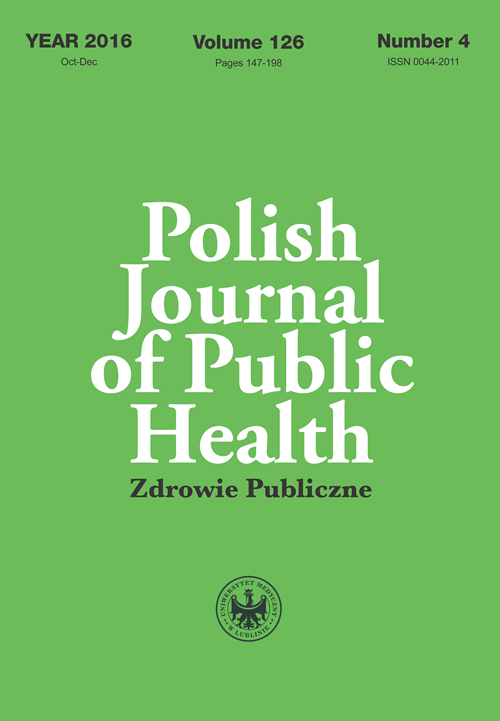Approximal Plaque Index, parameters of calcium-phosphate and iron metabolism and the quality of life of hemodialysis patients
DOI:
https://doi.org/10.1515/pjph-2016-0037Keywords:
Approximal Plaque Index, quality of life, end stage renal disease, calcium-phosphate metabolism, hemodialysisAbstract
Introduction. Hemodialysis patients require high standards in the field of dental diseases prevention and also in pharmacological and dialysis methods of combating biochemical disorders. It is necessary to question the methods of monitoring oral hygiene quality among hemodialysis patients.
Aim. The aim of this study was to determine the relationship between Approximal Plaque Index (API) and the quality of life and biochemical parameters of the calcium, phosphate and iron metabolism.
Material and methods. The study was conducted on a group of 124 individuals – 65 women (52%) and 59 men (48%) aged 24-90, volunteered to undergo hemodialysis in chronic renal failure, who consented to participate in this study. All participants of the study were treated for at least 6 months, through repeated hemodialyses in dialysis centers in Lublin. The dental examination was performed and Approximal Plaque Index (API) was determined. The Polish version of the quality of life questionnaire SF-36 was used. The values of urea, serum creatinine concentration, serum level of calcium, serum phosphorus, parathormone, transferrin, ferritin, and iron were also under control. The Kruskal-Wallis H test and Spearman Rank Correlation was used.
Results. Patients with optimal API reported higher levels of iron and lowest concentration of transferrin and serum phosphorus before HD. Patients who were characterized by high levels of phosphate and parathyroid hormone evaluated their functioning in the emotional sphere as worse compared to others. Higher concentrations of iron and transferrin favor a better sense of the quality of life.
Conclusions. Lower concentrations of phosphate before hemodialysis and higher iron levels contribute to maintaining optimal interdental hygiene in patients treated with renal replacement therapy. Normalization of biochemical parameters of calcium-phosphate and iron metabolism promotes a sense of better quality of life among patients on chronic hemodialysis. The level of interdental hygiene does not distinguish between general indicators of the sense of quality of life.
References
1. de la Rosa García E, Mondragón Padilla A, Aranda Romo S, Bustamante Ramírez MA. Oral mucosa symptoms, signs and lesions, in end stage renal disease and non-end stage renal disease diabetic patients. Med Oral Patol Oral Cir Bucal. 2006;11:E467-73.
2. Jover Cerveró A, Bagán JV, Jiménez Soriano Y, Poveda Roda R. Dental management in renal failure: patients on dialysis. Med Oral Patol Oral Cir Bucal. 2008;13:E419-26.
3. Sharma DC, Pradeep AR. End stage renal disease and its dental management. N Y State Dent J. 2007;73:43-7.
4. De Rossi SS, Glick M Dental considerations for the patient with renal disease receiving hemodialysis. J Am Dent Assoc. 1996;127:211-9.
5. Imirzalioglu P, Onay EO, Agca E, Ogus E. Dental erosion in chronic renal failure. Clin Oral Investig. 2007;11:175-80.
6. Chen W, Laiho S, Vaittinen O, et al. Biochemical pathways of breath ammonia (NH3) generation in patients with end-stage renal disease undergoing hemodialysis. J Breath Res. 2016;10:036011. doi: 10.1088/1752-7155/10/3/036011.
7. Sekiguchi RT, Pannuti CM, Silva HT Jr, et al. Decrease in oral health may be associated with length of time since beginning dialysis. Spec Care Dentist. 2012;32:6-10.
8. Proctor R, Kumar N, Stein A, et al. Oral and dental aspects of chronic renal failure. J Dent Res. 2005;84:199-208.
9. Franek E, Blaschyk R, Kolonko A, et al. Oral hygiene in haemodialyzed patients with chronic renal failure. Wiad Lek. 2006;59:184-8.
10. Ware JE Jr, Sherbourne CD. The MOS 36-item short-form health survey (SF-36). I. Conceptual framework and item selection. Med Care. 1992;30:473-83.
11. McHorney CA, Ware JE Jr, Raczek AE. The MOS 36-Item Short-Form Health Survey (SF-36): II. Psychometric and clinical tests of validity in measuring physical and mental health constructs. Med Care. 1993;31:247-63.
12. McHorney CA, Ware JE Jr, Lu JFR, Sherbourne CD. The MOS 36-item ShortForm Health Survey (SF-36): III Tests of data quality, scaling assumptions, and reliability across diverse patient groups. Med Care 1994;32:40-46.
13. Tylka J, Piotrowicz R. Quality of life SF-36 questionnaire – the Polish version. Kardiol Pol. 2009;67:1166-9.
14. Kiedrowicz M, Dembowska E, Banach J, et al. A comparison of the periodontal status in patients with type 2 diabetes based on glycated haemoglobin levels and other risk factors. Adv Med Sci. 2015;60:156-61.
15. Anumolu VN, Srikanth A, Paidi K. Evaluation of the relation between anemia and periodontitis by estimation of blood parameters: A cross-sectional study. J Indian Soc Periodontol. 2016;20:265-72.
16. Kanaffa-Kilijanska U, Kaczmarek U, Kilijanska B, Frydecka D. Oral health condition and hygiene habits among adult patients with respect to their level of dental anxiety. Oral Health Prev Dent. 2014;12:233-9.
17. Dalemo S, Eggertsen R, Hjerpe P, et al. Quality of life and health care consumption in primary care patients with elevated serum calcium concentrations in – a prospective, case control, study. BMC Family Practice. 2014;15:84.
18. Taji Y, Morimoto T, Fukuhara S, et al. Effects of low dialysate calcium concentration on health-related quality of life in hemodialysis patients. Clin Exp Nephrol. 2005;9:153-7.
19. Sturgill J, Howell S, Perry MM, Kothari H. Protocols for treating patients with end-stage renal disease: a survey of undergraduate dental programs. Spec Care Dentist. 2016;36:321-4. doi: 10.1111/scd.12197.
Downloads
Published
Issue
Section
License
Copyright (c) 2017 Polish Journal of Public Health

This work is licensed under a Creative Commons Attribution-NonCommercial-NoDerivatives 3.0 Unported License.


